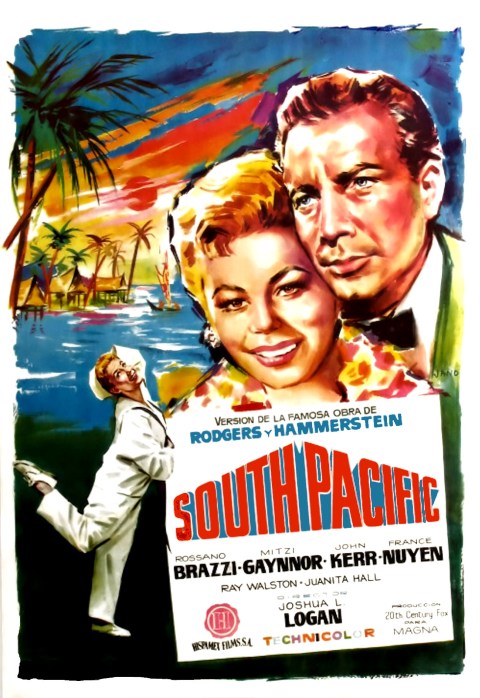17. 4. – 19. 4. 2026
South Pacific

 Original title: South Pacific
Original title: South PacificDirector: Joshua Logan
Production: 1958, USA
Length: 151 min. + intermission
Annotation for KRRR! 2018
Set against the backdrop of the Pacific War, Rodgers and Hammerstein's musical romance offers a critical look at racism in addition to the tried-and-tested combination of widescreen images, bold colors, and sweet, bittersweet songs.
Film was the dominant entertainment medium for decades. By the early 1950s, however, it had become just one of many ways to spend one's free time. In an effort to slow the decline of audiences, Hollywood studios opted for the path of overwhelming spectacle. Musicals seemed to be the ideal genre for making widescreen Technicolor blockbusters with lavish sets. Adaptations of Broadway plays were a guarantee of increased audience interest. In the 1940s and 1950s, considered the golden age of stage musicals, the joint work of lyricist Oscar Hammerstein and composer Richard Rodgers enjoyed particular interest. All of their greatest hits were gradually adapted for film: Oklahoma! (1955), Carousel (1956) and The King and I (1956). It was only a matter of time before the Pulitzer Prize-winning South Pacific would also appear on cinema screens, still showing in theaters five years after its premiere in April 1949. The basis of the sweeping narrative, which intertwines the story of a young US Army lieutenant in love and a naive nurse from Arkansas, who is forced to reconsider her racial prejudices by the events of World War II and her love for a wealthy French planter, was a short story from the collection Tales of the South Pacific by James A. Michener. He himself served as a soldier in the South Pacific during World War II, and therefore based his writing on his own experiences.
The director of the stage and film versions, Joshua Logan, tried to preserve the realistic dimension of the original by shooting on location (mostly on the Hawaiian island of Kauai), but at the same time, out of concern that the Technicolor colors would not stand out enough, he decided to use various color filters. "Flooding" the image with purple, gold, or red was intended (especially) during musical sequences to express the atmosphere and underline the emotions of the scene. At the same time, the color exuberance gives the film, inspired by real events and set in a natural environment, a slightly dreamy, surreal touch. However, the pronounced color transitions unpleasantly surprised Logan. Since most of the time it was not the result of post-production editing, but an effect achieved by placing a filter directly in front of the camera lens, laboratory editing was not possible. The filmmakers also did not have time for reshoots. The film was originally to be shown in its extended, almost three-hour version as a roadshow performance (a version shorter by a quarter of an hour was later produced for general distribution). The screening dates had already been set and tickets were being sold. Cancellation or postponement would have meant huge losses. Critics, who also resented the film's excessive (but commercially understandable) caution in adhering to the stage version, were just as annoyed as Logan, but the film charmed audiences. Until the premiere of The Sound of Music (1965), which incorporated realistic sets somewhat more effectively, it was Rodgers and Hammerstein's most commercially successful musical. The extraordinary interest was not dampened by the disgust of a certain Georgia legislator, who described the citizens of the American South in an open letter as proud and progressive people who could not accept the racial mixing that the film allegedly promoted.
South Pacific is a film with a simple love story, a humanistic message, and the dominance of music over the rather decorative visuals, which, however, manages to surprise with eloquent shot compositions. However, although it may seem a little stiff in these respects from today's perspective, from a historical perspective it is a very inspiring example of the qualities that Hollywood (successfully) relied on in an attempt to attract audiences to the cinema sixty years ago.